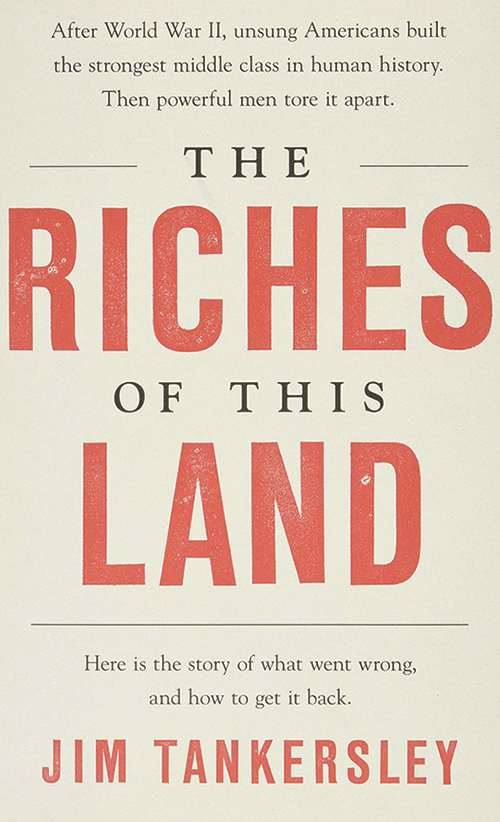
The Riches of This Land: The Untold, True Story of America’s Middle Class
Reviewed by J. E. McNeil
June 1, 2021
By Jim Tankersley. PublicAffairs, 2020. 320 pages. $28/hardcover; $17.99/paperback (available in September) or eBook.
Many people feel these days as though we are standing amid the ruins of the American Dream, and wonder how we got here. Jim Tankersley tells the story of the rise and fall of the U.S. middle class using data and analysis. He tells the stories of various families that rise and fall with it; the story of how politicians warped both the data and the stories for personal gain; and how journalists, mostly unknowingly, abetted the warping. “By focusing almost exclusively on distressed white guys, we [journalists] gave them the false idea that their trials were unique,” Tankersley admits. The story is chilling of how the myth began in the Reagan years and expanded. It is a book for our time.
There is a longing for the lost middle class to which White men who are not college-educated feel they should belong. Correspondingly, there are myths that good-paying jobs have been exported overseas, and Blacks, Latinos, women, and immigrants have “stolen” the jobs that remain. What’s not made clear is the fact that those jobs were increasingly lost not to people but to robots and computers, and to the changing expectations of younger consumers and workers. (For more information on the loss of jobs to automation rather than the export of manufacturing, read The War on Normal People: The Truth About America’s Disappearing Jobs and Why Universal Basic Income Is Our Future by Andrew Yang.)
Reading this book reminded me of President Lyndon B. Johnson’s explanation of the staying power of racism and segregation:
If you can convince the lowest white man he’s better than the best colored man, he won’t notice you’re picking his pocket. Hell, give him somebody to look down on, and he’ll empty his pockets for you.
The book also brought to mind the number of times I have heard childhood friends and others wax poetic about “the good old days.” From where we sat in our White, privileged, middle-class neighborhood, we believed the myth supported by films and television that blue-collar workers are White men, and their wives stay home and tend the children.
In reality, World War II opened new career opportunities to all women and to People of Color. The wartime economy increased employment around the country, which allowed for economic growth that continued long after the war. Unions pushed for wages and benefits that allowed families to enter the middle class: to buy cars and appliances and to take vacations. The Civil Rights Act of 1964 helped the middle class—not just the Black middle class—grow strong, and gave people reasonable expectations of their children doing even better.
Tankersley makes a compelling case that the advancement of women and People of Color in the labor market is intricately connected to the advancement of the workforce and economy on the whole:
The middle class as we understand it now is not limited to one color of collar, or to any color of the skin. . . . It is perhaps the most American of aspirations, a shared national myth that has the virtue of being true.
Everyone benefited, until they didn’t:
In recent years the middle-class mythos has been co-opted and narrowed by powerful white men who, in the time-honored tradition of ruling elites attempting to keep a crumbling hold on power, have convinced one group of distressed workers to blame their troubles on another group of distressed workers.
Such manipulation of the public’s perception helps pandering politicians to keep the ember of hate burning. Throughout the book, Tankersley discusses this dynamic in numbers and percentages but makes them real in the stories of families—Black, Latino, and White—across the decades and across the country. Intertwined with data are the voices of people making tangible the loss of manufacturing and other jobs before and during the pandemic. One of the Black men profiled in the book works multiple jobs to get by; he commented on complaints by White working-class men about landscaping jobs:
It used to be a hard, low-paying job that fewer white people wanted to do. Now the pay has improved, he said, and the workers are mostly nonwhite, and whites seem angry. “How can we steal something,” Ed said, “you just threw away?”
The lesson of this book is there are steps to take to get the U.S. middle class back, and I recommend reading it to develop a picture of Tankersley’s vision. Explication here would take too long, so I leave you with the words of Tankersley’s college mentor Bill Woo, a journalist turned college professor: “‘I really hope you keep this message with you always,’ Bill wrote. ‘There are no quick fixes, ever, for the things we hold dearest.’”
Like democracy.
J. E. McNeil is a member of Friends Meeting of Washington (D.C.) and has been an attorney and political activist for more than 50 years. She is always grateful for the opportunity to learn more about the ins and outs of the United States and its economy, and to work for justice within it.


